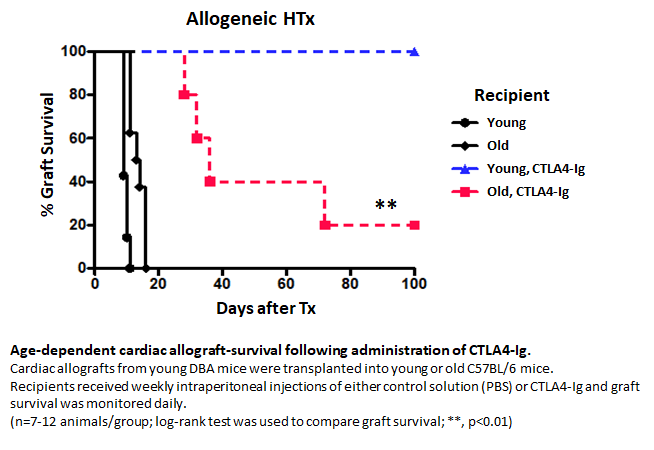CTLA-4-Ig prolongs graft survival specifically in young but not in old recipients
Jasper Iske1,2, Timm Heinbokel1,3, Ryoichi Maenosono1,4, Yeqi Nian1,5, Markus Quante6, Koichiro Minami1,4, Haruhito Azuma4, Abdallah Elkhal1, Stefan G. Tullius1.
1Department of Surgery, Brigham and Women's Hospital, Boston, MA, United States; 2Institute of Transplant Immunology, Hannover Medical School, Hannover, Germany; 3Department of Nephrology, Charite Universitätsmedizin Berlin, Berlin, Germany; 4Department of Urology, Osaka Medical College, Osaka, Japan; 5Department of Kidney Transplantation, Tianjin First Central Hospital, Tianjin, People's Republic of China; 6Department of Surgery, University Hospital Tuebingen, Tuebingen, Germany
Introduction: The proportion of older transplant recipients has increased dramatically. Age-specific effects of established immunosuppressants are poorly understood. Here, we assessed the impact of CTLA4-Ig, a fusion protein blocking costimulatory signaling between APCs and T cells through CD28. We hypothesized that the immunosuppressive capacity of CTLA4-Ig will depend on an age-specific expression of CD28 on alloreactive T-cells.
Methods: Heart and skin grafts from young DBA2/J mice were transplanted into either young or old (2-3 and 18 mths, resp.) allogeneic C57BL/6 recipients treated with CTLA4-Ig or PBS; T-cell frequencies and subsets in addition to cytokine expression were assessed by flow cytometry and ELISA; expression of CD28 was assessed on young and old T-cell subsets. To delineate the age-specific immunosuppressive potential of CTL4-Ig, T-cells were transfected with a lentiviral vector inducing CD28 expression; transfected T-cells were subsequently transferred into young RAG2-/- mice receiving a fully mismatched skin graft.
Results: Treatment with CTLA4-Ig prolonged skin graft survival only in young (p<0.01) but not in old recipients (p=0.33). Age-specific immunosuppressive effects of CTLA4-Ig were also confirmed in a SOT model: cardiac allografts in young mice treated with CTLA4-Ig survived indefinitely. In contrast, 80% of old recipients treated with CTLA4-Ig had lost their graft by 100 days. CTLA4-Ig reduced CD4+ central-memory and effector-memory T cells and diminished systemic IFN-γ levels only in young (p<0.05), but not old recipients (p=0.8). These differences correlated with a reduced expression of CD28 on antigen-experienced CD4+ T cells in old mice (p<0.001). Interestingly, Tregs displayed an increased expression of CD28 with age making them more prone to be targeted by CTLA4-Ig. Strikingly, adoptive transfer of old CD4+ T cells that were transfected with a lentiviral vector augmenting the expression of CD28 accelerated the rejection of allogeneic skin grafts in young RAG2-/- recipient mice (p<0.01 vs. controls animals that received adoptively transferred, non-transfected old T cells) demonstrating the cardinal role of CD28 expression on alloreactive CD4+ T cells.
Conclusion: Immunosuppressive effects of CTLA4-Ig showed distinct age-dependent effects in both skin and cardiac transplantation linked to a reduced CD28 expression of alloreactive old T-cells in parallel to an augmented CD28 expression on old T-regs. Transfection experiments confirmed the critical role of CD28 in mounting robust alloimmune responses. These findings carry relevant clinical consequences.

